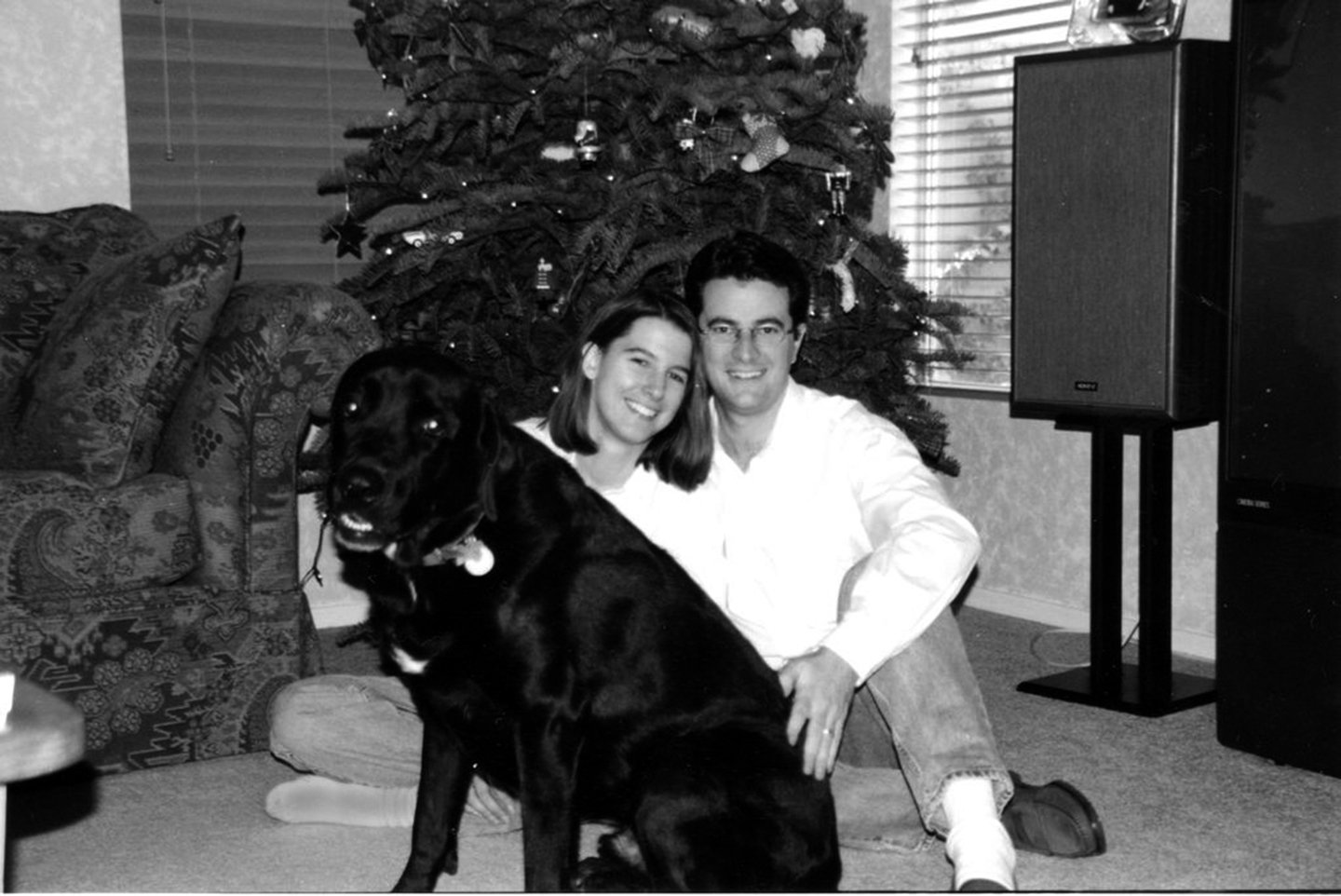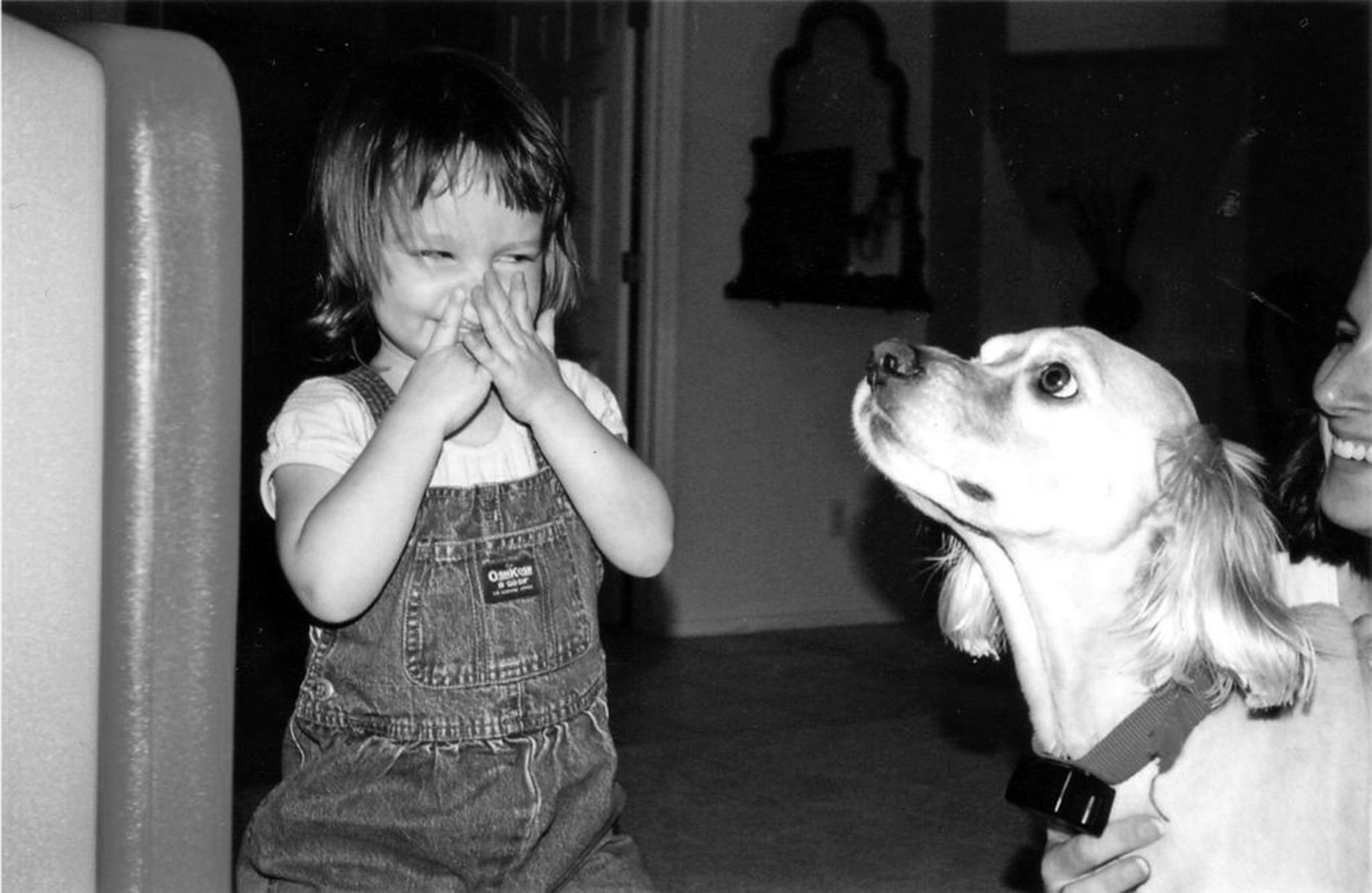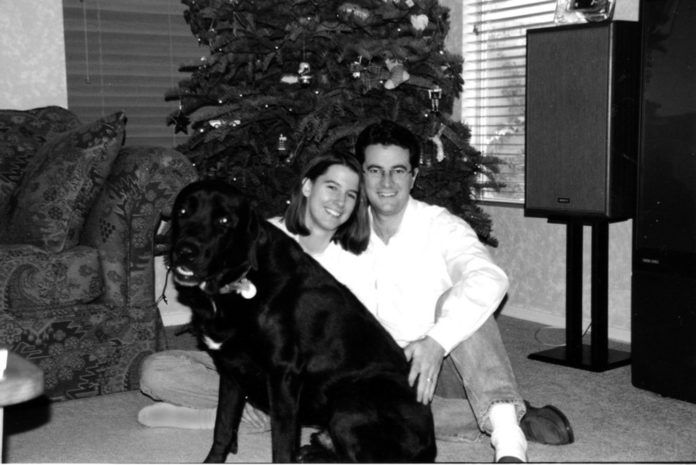
Charlie was, to put it mildly, impossible. The black Lab-rottweiler mix chewed up Heather and Steve Lampert’s couch. He dug up the drip line for their outdoor plants while they were at dinner one night and then, when they came home, ran around the house excitedly, putting his muddy paw prints all over the carpet because he was eager and proud to lead them to the flood he had created in their back yard. He also ate two Queen palm trees. He was, in other words, their very own Marley.
The Lamperts, she an accountant and he a physician, adored him and to this day talk lovingly about him.
The Phoenix couple were only in their mid twenties when they adopted him as a puppy from the Humane Society, only a few years after they married. “We had just bought a house,” Mrs. Lampert says. “We were sort of nesting. We weren’t quite at that stage yet where we were ready to have kids, but Charlie was our baby, our child.
“We doted on him more because we didn’t have children. We bought a book of where you could travel with your pet, listing hotels that were dog-friendly.”
“We were in love with him for sure,” Dr. Lampert says.
The Lamperts are by no means in a class by themselves. It takes viewing only a few episodes of House Hunters on HGTV to learn that many young couples, prior to starting a family, “parent” a dog in a kind of role rehearsal. One of their “must haves,” along with the granite countertops, the open floor plan, and the en suite bathroom with two sinks, is often “a fenced-in backyard for Bailey” or “Max” or “Daisy.”
“There’s nothing wrong with the instinct to nurture a dog before nurturing a child,” says Cummings School Behavior Clinic director Nicholas Dodman, BVMS. “Dogs provide great companionship for couples without children, whether they’re delaying starting a family or choosing not to have one.” But “you really have to be a parent,” he advises. “It means not always doing everything the dog wants when he wants it. Dogs, like children, benefit from having some kind of structure, some kind of expectations of them.”
Dr. Dodman is referring to the fact that a lot of couples fuss over their dog and pamper it to the point that the dog, particularly if it has a genetic propensity to be at least somewhat willful or pushy or act aggressively, becomes out of control. “The pampering can be interpreted as a kind of weakness,” Dr. Dodman says. “The dog takes advantage of the situation because he’s not being given cues to behave otherwise.” And that can create problems once a child does come along. Even a dog who is aggressive only sometimes, Dr. Dodman says, can present a danger for a new, defenseless intruder on his space.
Charlie was neither aggressive nor pushy. He was simply exuberant, although he did have a way of wrapping the Lamperts around his paw.
The way to rein in a dog, whether willful or crazily exuberant, is to create rules, just like you would for a child. “It means not always doing everything the dog wants whenever he wants it,” Dr. Dodman says. “Put some structure into the relationship with a ‘learn to earn’ program.” That is, the dog should learn to work for treats, for attention. He should not be handed everything on the proverbial silver platter. That’s not good for any dog. It creates anxiety because dogs cannot really handle being in charge in a human household. But structure and discipline are especially important for a dog who may someday have to share you with other “children.” Life is exhausting enough with a new baby. You will more than have your hands full if you also have to contend with a dog you have taught to expect his every whim will be catered to.
So as with any dog new to your household, children or not,Dr. Dodman cautions that you should “say what you mean and mean what you say. Have a few house rules, and set limits for acceptable behavior. Definitely,” Dr. Dodman says, “indulge your new dog like crazy. Love him, cuddle him, nurture him, play with him. Just don’t give in to overbearing demands. If the dog comes with a willful bent, keep him off high places like beds and couches, and perhaps make him do a trick before you play ‘fetch’ or ‘Frisbee’ with him. Once you create a framework of a reasonable household structure where life doesn’t completely revolve around the dog,” Dr. Dodman says, the affection and general permissiveness you demonstrate to him won’t become a signal that he rules the roost to the exclusion of all other considerations.

When the new baby comes home
Having some house rules for a dog while treating him affectionately will help enormously with your pet’s adjustment once a baby comes along. Let’s be honest. Once you have a child, on some level the dog must learn to play second fiddle. If everything has gone exactly his way until B-day, that is, if you have raised your dog to be what Dr. Dodman calls a “yuppy puppy” who gets whatever he wants whenever he wants it, it is going to be an especially rough transition when someone else comes along who has to be fed every two hours and gets cooed over all the time. Teach the dog that the sun doesn’t rise or set because of him, on the other hand, and he’ll be in a better position to deal with a newcomer who’s going to get the lion’s share of attention.
That said, it would be cruel to relegate the dog to a kind of persona non grata state, ignoring his need to be loved and cared for. Try as hard as you can, even with a demanding baby, not to depart from your pet’s routine. If you take him out four to five times a day, work to continue to do so, even if it’s with the baby carriage alongside you. Don’t ignore him, either. So many new parents make the mistake of giving their dog short shrift while the baby is awake, then trying to pay him some attention when the baby takes a nap or goes into his crib for the night. It sends the worst message to the dog that times are good only when that “little squirmy thing” is out of the picture, paving the way for resentment and the lack of a bond between them.
Instead, when the baby comes home from the hospital, immediately let the dog sniff him, which is the dog’s way of identifying the newborn as a pack member and welcoming him into the fold. Also, “don’t exclude the dog from family affairs,” Dr. Dodman says. Allow him to be present when the baby is nursed. Even try to make it exciting when the baby is around, maybe throwing him his favorite squeaky toy or giving him a nice belly rub or petting session, or even a couple of food treats. “Most people do the opposite,” Dr. Dodman laments. “They say, ‘Put Toby away; put him in his cage.’ Then they treat the dog well after the baby has gone to bed, teaching him that ‘that thing’ has wrecked his life. You don’t want that kind of ‘sibling’ rivalry.”

Once the baby gets a little older
At a certain point the baby’s going to start crawling, then walking. It’s then that you need to begin to protect the dog from the baby, not just worry about the safety of a baby with a frustrated dog. Be sure the dog can always retreat to his own personal space — whether a crate or dog bed — in an out-of-the-way spot that the child can’t get near. That will give him time to collect himself calmly if he wishes to temporarily escape what he perceives as the child’s quick, unnerving movements.
Also, keep your child’s toys and your dog’s toys separate, and make sure your child cannot get near the dog’s belongings. A dog may guard his toys jealously, and it’s too hard to tell small children to stay away from Fido’s colorful, squeaky, fuzzy things. (And you certainly don’t want the dog telling him!)
Finally, don’t let your small son or daughter eat on the run. Toddlers are very much at a dog’s eye level, and a cookie or a small piece of meat flying by could prove too tempting to your dog — and result in a bitten finger in addition to a bitten chicken nugget.
Unfortunately, the Lamperts never got to broker a relationship with Charlie and their two children. He died at age four of what appeared to be a splenic tumor while Mrs. Lampert was pregnant with their first child. They took in another dog, a cocker spaniel mix named Pearl, when their elder daughter was an infant. A family they knew was moving out of state and asked the Lamperts to adopt her.
But while the Lamperts were good to Pearl, and while their daughters adored her and loved to try to dress her up, she was more aloof than Charlie had ever been from the get-go. “You’d throw a ball, and she’d just kind of look at you,” Dr. Lampert says. “She kind of did her own thing.”
Granted, that made it easy to have her with two very young children in the house. “She was very low maintenance,” Mrs. Lampert says. “It would have been different with a dog who needed a lot more attention. But we did not have the same intensity of feeing toward Pearl. It was hard when she died [years later at age 11], but not devastating like with Charlie.”





